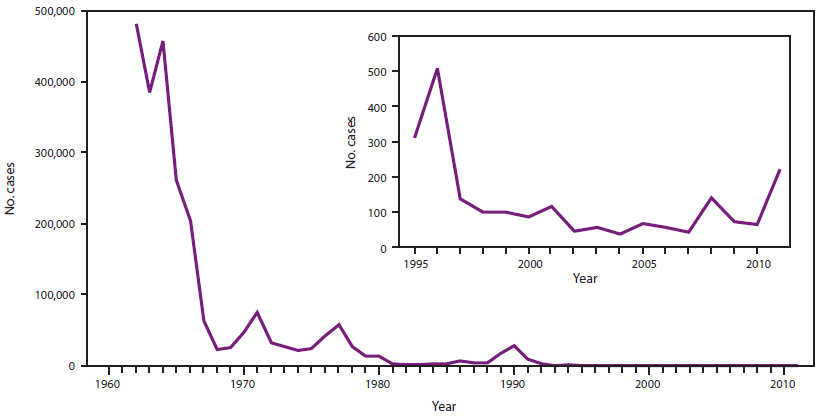Philadelphia was under attack through
the winter and spring of 1991.
The name of the enemy? Measles.
The Philadelphia outbreak – the
city’s first since 1954 - began in October 1990, and quickly spread throughout
the unvaccinated population. Within six months, 938 cases of the highly contagious disease had been reported to the
city's health department.
What brought the most controversy,
however, were an addition 486 cases identified among the parishioners of two
churches that opposed medical treatment. More than half of the 892 mostly
unvaccinated church members contracted the virus. Six children who died during
the outbreak were part of these church families.
Even as city officials pleaded with
the families to get their children medical attention and went door-to-door in
February in a frantic monitoring effort, some in the Faith Tabernacle
Congregation and the First Century Gospel Church were defiant.
The Rev. Charles Reinert of Faith
Tabernacle told the Philadelphia
Inquirer in February, after four children from his church had already
died, "We do not believe that our children are neglected or abused whatsoever
by our trusting God. We believe the healing power of our Almighty God is far
superior to any care a man could offer."
The previous week, the city obtained
court orders to hospitalize two extremely ill after
their parents refused to get them medical care.
Paul Offit saw some of these kids at Children's Hospital of
Philadelphia, where he still works. The veteran pediatrician and co-inventor of
the rotavirus vaccine has since dedicated himself to fighting antivaccine
campaigns as they’ve arisen.
It became apparent that spring that the
parents from the church wouldn’t listen to health officials, so the city sought
an order from a judge to immunize six children from the church deemed at risk.
The request
was granted in early March, but only five got
the shots. The
sixth died before he could be inoculated.
This war over medical science
occurred long before Andrew
Wakefield, Jenny
McCarthy, or the rest of today’s antivaccination movement got off the
ground. Opposition to vaccines has existed since they were first invented, even
if the reasoning constantly shifts.
“It’s like playing whack-a-mole,” Offit said in an
interview. “First it was the MMR vaccine, then thimerosal, then ‘too many, too
soon,’ then HPV, then chronic fatigue syndrome…”
Still, he thinks things have gotten
better in the last decade-and-a-half. “I
think we’re winning,” he said.

The number of measles cases in the United States from 1962
through 2011. After the introduction of the 1-dose measles vaccination program,
the number of reported measles cases decreased during the late 1960s and early
1970s to approximately 22,000-75,000 cases per year. Image courtesy of the CDC.
The government’s got his back. The
compulsory vaccinations in 1991 may have been unprecedented, but more recent
outbreaks of preventable diseases like pertussis have convinced some
states to tighten restrictions on vaccine exemptions. California, Washington and Oregon have all made it more
onerous to opt out of vaccination, especially on the basis of “personal
belief”; Colorado and Utah have considered similar changes. Some people –
including Offit – are challenging religious exemptions in other states.
Is requiring vaccination overly
coercive? Offit doesn’t think so; he pointed out that there are many examples
where public safety trumps personal freedom.
“We coerce people to put seatbelts
on. We coerce people to stop at stop signs. I think it’s no different. It’s
important not just for you, but for your family, friends, and all those around
you,” he said.
Coercion in matters of public health have
a long history in the U.S. Quarantine was used extensively prior to the
development of modern treatments. During a
massive epidemic of yellow fever in the South
during 1878 for example, numerous towns and counties established quarantines,
even if it meant halting business with the outside world altogether. Jackson,
Tenn., was one of the few cities to escape the ravages of the fever, thanks to
its strict quarantine measures.
Offit said that although coercion is
a legitimate tool, he prefers persuasion. And he uses it all the time.
“There’s a prism through which we
(health experts) communicate; we talk to the media.” However, he cautioned, “It
can be an opaque prism.”
Offit said that the trying to
communicate through journalists can be difficult because they have standards
that differ from those of the medical community. They may tell two sides of the
story when only one has the science to support it – especially if it creates
the impression of controversy. In addition, some of the people identified as
“experts” know nothing about their subject – they’ve never published a paper,
never had training, never filed anything for approval. “They might as well have
been plucked off the street,” he said.
It’s not that Offit minds answering questions, from the
media or from patients. Indeed, he thinks the evidence is usually compelling,
once people have heard it.
Offit acknowledges, though, that a small segment of the
population may never be swayed, no matter how well the information is
communicated. They should be prevented from sickening or killing others.
But that’s not the vast majority of the population, for whom
persuasion is enough. Vaccine uptake remains high overall, and people generally
trust their doctors.
“When people get sick, they go to a doctor, not to Jenny
McCarthy,” he said.


